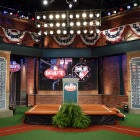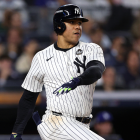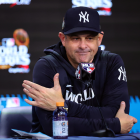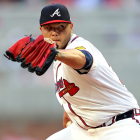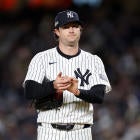Major League Baseball's annual amateur draft has finally arrived.
The three-day event started Monday night with the first 75 picks during a live MLB Network broadcast. That covers the first round, supplemental first round, competitive balance round A, second round and competitive balance round B.
The Minnesota Twins, thanks to their 59-103 record in 2016, held the No. 1 overall pick for the third time in franchise history. They selected Tim Belcher in 1983 and Joe Mauer in 2001. The Twins used that No. 1 pick on California high school shortstop/center fielder Royce Lewis. This is the second straight year a prep position player was selected first overall. The Philadelphia Phillies chose California high school outfielder Mickey Moniak with the top pick last summer.
The entire MLB draft covers 40 rounds -- it used to be 100 rounds way back in the day -- and it's important to note three teams did not have a first-round pick this year. They surrendered their first rounder to sign a qualified free agent over the winter. Here's the list:
- Colorado Rockies: Forfeited 11th overall pick to sign Ian Desmond.
- St. Louis Cardinals: Forfeited 19th overall pick to sign Dexter Fowler.
- Cleveland Indians: Forfeited 25th overall pick to sign Edwin Encarnacion.
Also, the Cardinals had to send their second (56th overall) and third (75th overall) picks to the Houston Astros as compensation for the hacking scandal. St. Louis did not have a pick on Day 1. They won't make their first selection until the third round, 94th overall.
We here at CBS Sports provided instant analysis of all 27 first-round picks Monday night, live as the selections were announced. Here is our breakdown of the 2017 first round.
| 1 | |
| The Pick: SS/OF Royce Lewis, JSerra Catholic HS (California). Lewis may have the best tools of any position player in the draft, headlined by top-of-the-scale speed on the bases and excellent power at the plate. It's not certain he'll be a shortstop long-term, but if he doesn't he may have a future at another premium position in center field. | |
| 2 | |
| The Pick: RHP/SS Hunter Greene, Notre Dame HS (California). Greene would almost certainly be a first-round pick as a hard-hitting shortstop, but his future on the mound that makes him the consensus best talent available. Greene throws four pitches for strikes, including fastball that touches triple digits and a plus slider. He also has the foundations of a usable big-league changeup. Greene won't turn 18 years of age until August. | |
| 3 | |
| The Pick: LHP MacKenzie Gore, Whiteville HS (North Carolina). As prep lefties go, Gore boasts solid velocity and excellent command. He's also got command of four pitches and advanced feel for his age and level, as he's highly adept at changing speeds. High school left-handers are never drafted as finished products, but Gore's about as close as you can get. | |
| 4 | |
| The Pick: LHP/1B Brendan McKay, Louisville. McKay's another two-way talent. For the U. of Louisville this season, he pitched to a 2.34 ERA with 140 strikeouts in 104 innings. At the plate, he batted .343/.464/.657 with 17 homers in 61 games. He's likely to be drafted as a hitter. Power was the only question coming into the season, but McKay's answered that one in a big way. | |
| 5 | |
| The Pick: RHP Kyle Wright, Vanderbilt. The Vandy righty figures to move quickly once he's drafted and signed. Wright has command of four pitches, including a swing-and-miss changeup and two breaking balls. On occasion he sits mid-90s with his fastball. He's also got a good starting pitcher's frame, and he comes from a program with a knack for developing big-league arms. | |
| 6 | |
| The Pick: OF Austin Beck, North Davidson HS (North Carolina). Beck's speed and strong arm should allow him to stick in center field, given more experience. His outstanding raw power, however, should allow his bat to play anywhere. Contact and pitch recognition will be the challenges for Beck as a pro, but the power is some of the most impressive in the 2017 draft class. | |
| 7 | |
| The Pick: 1B Pavin Smith, Virginia. It's tough for a first baseman to go high in the draft. Smith should prove to be the exception, however, based on his potential for above-average hit and power tools. How good was his approach? He finished the season with more home runs (13) than strikeouts (12). If there's a knock on Smith, it's his athleticism. He's a well-below-average runner who is likely to remain at first base. Still, he should hit -- and that'll get him picked early. | |
| 8 | |
| The Pick: OF Adam Haseley, Virginia. A 6-foot-1 lefty, Haseley was both a pitcher and outfielder in his collegiate career. In the pros, he'll likely stick to the latter. As a junior this season, he hit .390/.491/.659 with 16 doubles, 14 home runs, 56 RBI, 68 runs and 10 steals in 58 games. Not surprisingly, given his pitching prowess, Haseley has a strong arm from the outfield and great overall athleticism. | |
| 9 | |
| The Pick: 2B/OF Keston Hiura, UC Irvine. Hiura is an interesting prospect. All he's done is hit, hit, and hit some more -- and the belief is he'll continue to hit. It's unclear where he'll play, however, as he's been limited to DH duty all season by an elbow injury. In the past, he's played both second base and center field. There's certainly reason to see if he can hang up the middle, but a professional team could throw him in left (due to his below-average arm) and let him hit his way into the majors. | |
| 10 | |
| The Pick: OF Jordon Adell, Ballard HS, (Kentucky). Based on raw tools, Adell has one of the highest ceilings in the draft. He can run, throw, and has above-average raw power (thanks in part to his lightning-fast bat). The sticking point on Adell is whether any of that will matter. There's concern about how well he'll be able to hit due to at-times questionable pitch recognition. If Adell ease those concerns, he could become a steal. | |
| 11 | |
| The Pick: 3B Jake Burger, Missouri State. Burger is one of the top college hitters in a draft short on them. An optimist looks at him and sees a third baseman with five average or better tools. A pessimist sees a batter with potentially problematic hitting mechanics. The truth is probably somewhere in between. Burger will have done wonderfully if he has as good a career as another Missouri State product: Bill Mueller. | |
| 12 | |
| The Pick: RHP Shane Baz, Concordia Lutheran HS (Texas). Baz can touch the high-90s with his fastball, and he complements it with a refined cutter and a pair of promising breaking pitches. While Baz figures to pitch exclusively as a pro, he also boasts impressive right-handed power at the plate. Whoever signs him must buy him out of a commitment to TCU. | |
| 13 | |
| The Pick: LHP Trevor Rogers, Carlsbad HS (New Mexico). Can you say projectable? Rogers is a 6-foot-6 lefty who already throws mid-90s. In and of itself, that's a combination that makes scouts see stars. He mixes in a slider/hard curve along with a change that he in high school hasn't really needed much yet. The only real concerns are how little he's been challenged to this point, but he's only 19 and that's something that can be fixed in pro ball. | |
| 14 | |
| The Pick: 1B Nick Pratto, Huntington Beach HS (California). Typically, there aren't many prep first basemen drafted in the top-10. Pratto ought to be, though, due to his offensive potential. He marries a high-quality approach and feel for contact with improving power. Pratto is a quality defender with a strong arm, and has pitched in the past. He's going to be a first baseman as a professional, however, and he could become a good one. | |
| 15 | |
| The Pick: RHP J.B. Bukauskas, UNC. Bukauskas has a fastball that touches the mid-90s, but his slider -- probably the best breaking pitch in the entire draft -- is his calling card. That slide-piece helped him strike out 116 batters in 92 ⅔ innings this past season against ACC competition. Bukauskas will need to cultivate his changeup if he's going to be a part of a big-league rotation, but there's time for that. | |
| 16 | |
| The Pick: RHP Clarke Schmidt, South Carolina. Through nine starts, Schmidt looked like a top 10 pick. He was 4-2 with a 1.34 ERA and 70 strikeouts against 18 walks in 60 ⅓ innings. He works up into the high-90s with movement on his fastball and teams it with a very good slider and a change. Of course, he injured his elbow after those nine starts and has had Tommy John surgery. So there's some risk here and he won't be helping the ballclub for a few years. There's huge upside, though. | |
| 17 | |
| The Pick, 1B Evan White, Kentucky. White's athletic and rangy, and he can run. Since he's a college first baseman with first-round potential, he can also hit. While he doesn't profile as a power hitter at the highest level, he should hit for average and control the strike zone. White is also an excellent defensive first baseman. | |
| 18 | |
| The Pick: RHP Alex Faedo, Florida. Faedo saw his stock slip a little early on, as he was working his way back from knee surgery. He's since repositioned himself back toward the front of the class, thanks in large part to his fastball-slider combination. Both pitches profile as above-average offerings. Add in his big frame and increasing feel for his changeup, and he's well positioned to become a big-league starter. | |
| 19 | |
| The Pick: OF Heliot Ramos, Leadership Christian Academy (Puerto Rico). Few prospects leave scouts as divided as Ramos. He's a righty hitter with a chance to hit for big power, and those who like him see enough bat-to-ball skills to allow Ramos to consistently tap into his power at the next level. His detractors see less than stellar pitch recognition and plate discipline. Ramos has decent speed and an okay arm. He's expected to slide over from center field to a corner spot down the line. Ramos is committed to Florida International. | |
| 20 | |
| The Pick: LHP David Peterson, Oregon. You might have heard about Peterson in late April, as he struck out 20 in a four-hit shutout against Arizona State. It's been that kind of year for the 6'6" power lefty. He's 11-4 with a 2.51 ERA and 140 strikeouts against only 15 walks in 100 ⅓ innings. He works with a low-90s, sinking fastball, a reportedly very good change and a curve. | |
| 21 | |
| The Pick: LHP D.L. Hall, Valdosta HS (Georgia). A smallish lefty with a commitment to Florida State, Hall has a few things working in his favor. For one, his fastball is lively and can touch the mid-90s. For another, his breaking ball profiles as a capable out pitch. He needs to continue to refine his command and changeup, but there's at least mid-rotation starter potential here. | |
| 22 | |
| The Pick: SS Logan Warmoth, UNC. In addition to having one of the best surnames in the draft, Warmoth is a well-rounded prospect who lacks both a standout tool and a glaring weakness. He combines average potential at the plate with enough defensive ability to stick up-the-middle. The main question with Warmoth is whether he'll be able to stay at shortstop. Worst comes to worst, he should be fine at second. | |
| 23 | |
| The Pick: OF Jeren Kendall, Vanderbilt. Kendall is a burner, one blessed with well-above-average foot speed that he puts to good use in center field and on the basepaths. At the plate, Kendall has more power than you'd expect, and he homered 15 times during the regular season. Given his experience against high-level competition, and his potential for five average or better tools, don't be surprised when he goes early in the first round. | |
| 24 | |
| The Pick: RHP Tanner Houck, Missouri. Drafted out of high school in the 12th round by the Blue Jays, Houck chose to attend Mizzou instead and it has paid off. The burly 6-foot-5 right-hander has been in the Tigers' rotation from the get-go. As a sophomore in 2016, he was reaching high-90s with movement, but reports indicate he's dipped a bit this season as his stock has fallen from a likely top-10 overall pick. He mixes in a slider and change to round out his arsenal. This season, he was 4-7 with a 3.33 ERA and 95 strikeouts in 94 ⅔ innings. | |
| 25 | |
| The Pick: LHP Seth Romero, Houston (dismissed). There's big upside here with great risk. Romero's as talented as they come, a lefty who can sit low-to-mid 90s with his fastball and has an above-average slider. In 48 ⅔ innings for Houston this spring, he struck out 85 hitters. He walked 20, though, with a 3.51 ERA. He has also been suspended multiple times, including for a failed drug test, before being kicked off the team reportedly for a fight with a teammate. His weight has also fluctuated at times, rising to close to 250 at one point, reports indicate. | |
| 26 | |
| The Pick: OF Bubba Thompson, McGill-Toolen HS (Alabama). The Alabama commit had interest from several SEC schools to play quarterback, but he has insisted he will concentrate on baseball. An all-around stellar athlete, Thompson shows excellent speed and arm strength along with good power. Reports also indicate his makeup and work ethic are strong. | |
| 27 | |
| The Pick: LHP Brendon Little, State College of Florida. A draft-eligible sophomore, Little transferred from North Carolina following his freshman season. He combines an above-average fastball with a promising breaking ball. Little has to do a better job repeating his mechanics, and will need to continue working on his changeup. His fastball and bat-missing ability will coerce some team into picking him early on. | |


































